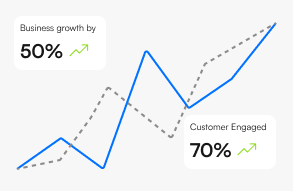Deciphering Consumer Behavior: The Role of Chatbot Analytics

Rajesh Bhattacharjee
January 03, 2024
5 min

Table of Contents
The use of AI chatbot builder has significantly increased, partly due to the pandemic accelerating AI adoption and OpenAI introducing ChatGPT. Around 58% of B2B businesses and 42% of B2C businesses use AI Chatbots actively.
Companies in all industries such as healthcare, retail, and finance are boosting their investments in artificial intelligence based chatbots for its diverse use cases. This has resulted in enhanced revenue growth and decreased marketing expenses.
Importance of Chatbot Analytics
- 1. Focus on relevant KPIs
Chatbot analytics enable businesses to concentrate on key performance indicators (KPIs) most relevant to their goals and objectives. - 2. Prevention of potential failures
By analyzing the right metrics, companies can identify and mitigate potential issues before they escalate, ensuring smoother chatbot operations. - 3. Data collection under privacy regulations
Improved data collection methods are facilitated by chatbot analytics, which is especially crucial in the context of evolving data privacy laws. - 4. Customer insights and journey
Analytics from chatbots offer crucial data on customer habits and choices,[right from their conversations thus](https://www.thinkstack.ai/blog/ai-driven-intent/), assisting companies in comprehending and improving the customer experience.
Key Metrics in Chatbot Analytics
To effectively track and evaluate the performance and impact of your chatbot, consider the following essential metrics that gauge its efficiency, effectiveness, user satisfaction, and contribution to achieving business objectives.
- 1. User Satisfaction
This metric measures how well users rate their experience with the chatbot. It often involves direct feedback mechanisms like surveys or rating systems post-interaction, providing a quantitative measure of user contentment with the chatbot's performance. - 2. User Sentiment
Beyond essential satisfaction, user sentiment delves deeper into analyzing the emotions and attitudes expressed in users' conversations with the chatbot. This involves sentiment analysis algorithms that can detect nuances in language to infer users' true feelings, which might not be explicitly stated in feedback. - 3. T-Total Conversation Messages
Messages Sent by Chatbot: This refers to the total count of messages sent by the chatbot to users. It's a measure of the chatbot's activity level and interaction frequency. - 4. Messages Received from Users
This tracks the number of messages users send to the chatbot, indicating user engagement and how actively they interact. - 5. Self-service Rate
This is the percentage of queries or issues users resolve using the chatbot without human intervention. A high self-service rate typically indicates a more efficient chatbot, contributing significantly to business cost savings and ROI. - 6. Below Threshold Messages
Known as 'missed messages' or 'below threshold' responses, these are instances where the chatbot fails to understand or respond appropriately to user queries. Tracking these helps identify gaps in the chatbot's capabilities and areas needing improvement. - 7. Fallback Rate
This metric indicates how often the chatbot resorts to default responses or escalates queries to human agents due to its inability to provide relevant answers. It's crucial for assessing the chatbot's effectiveness and identifying areas for enhancement. - 8. Leads Generated
This measures the number of potential customers or inquiries generated through interactions with the chatbot. It's particularly relevant for chatbots used in marketing and sales, as it directly correlates with potential revenue generation. - 9. Intent Match Rate
This rate assesses how accurately the chatbot identifies and matches user messages to predefined intent categories. High accuracy in intent matching is critical for ensuring the chatbot understands and responds to user queries effectively. - 10. Segment Identification Rate
Utilizing NLP, this rate measures how effectively the chatbot categorizes users based on their interactions and preferences. It aids in personalized responses and targeted marketing efforts. - 11. Goal Completion Rate
This metric evaluates the chatbot's effectiveness in achieving specific predefined goals or functions, like resolving a query or facilitating a transaction. It directly indicates the chatbot's success in fulfilling its intended purpose. - 11. Users
Unique Users: Counts the distinct individuals who have interacted with the chatbot over a given period, providing insights into its reach. - 12. Active Users
Tracks users who engage with the chatbot regularly, indicating the engagement and stickiness of the chatbot. - 13. New Users
The number of first-time chatbot users is crucial for understanding its growth and user acquisition. - 14. Retention Rate
Measures how often users return to interact with the chatbot, an essential metric for understanding user loyalty and the long-term value of the chatbot.
Benefits of chatbot analytics:
- 1. Understanding customer needs
Chatbot conversations are a valuable data source for understanding customer wants and needs, especially in conversational commerce. - 2. Improving customer experience
Data on customer satisfaction obtained from chatbot analytics can be used to refine chatbot strategies and enhance the quality of service. - 3. Efficiency for human team members
By handling routine queries, chatbots reduce the workload on human customer service teams. Analytics help identify areas where chatbots can be further trained to handle more complex inquiries. - 4. Enhancing product information
Chatbots provide insights into customer queries and confusion points, which can be used to improve product information and features. - 5. Boosting sales
Analytics can reveal how chatbot interactions influence sales and customer satisfaction, helping identify improvement areas to increase sales.
Challenges with Conversational AI
Despite their advancements, AI chatbots could be more flawless and require continuous tweaking and testing. Inadequate responses or misunderstanding of user requests can harm a brand’s reputation and revenue. Therefore, constantly monitoring and adjusting chatbot responses based on performance is crucial.
To sum up, AI chatbots are a significant company asset, providing numerous advantages, including better customer interaction and advanced sales and marketing tactics. However, their success hinges on the effective use of analytics to monitor and improve their performance continuously.
Businesses can optimize their chatbots to meet their objectives better and enhance customer experiences by focusing on key metrics and understanding customer interactions.

Grow Your Business with AI Chatbots
- Automate tasks
- Engage customers 24/7
- Boost conversions